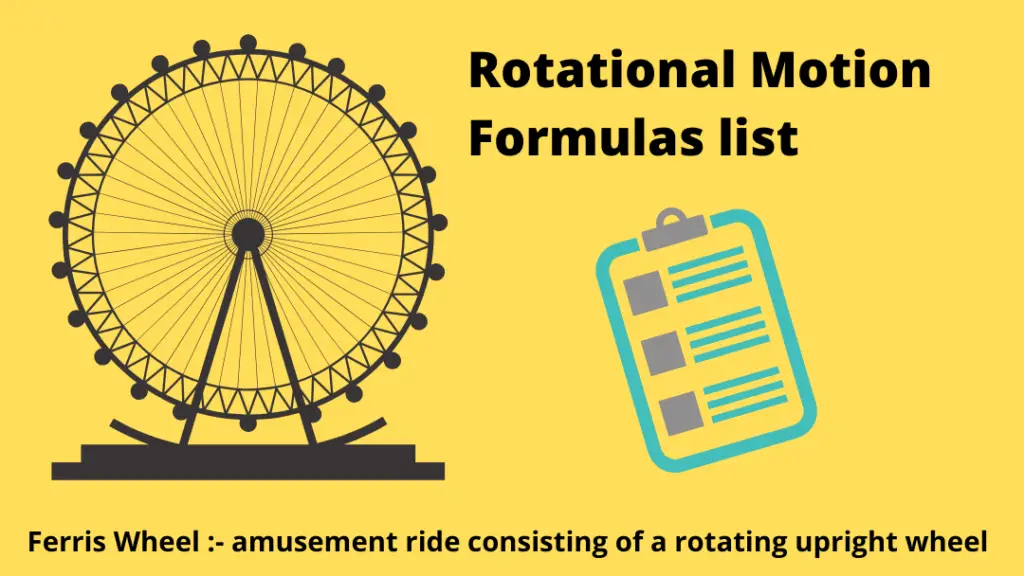
This Rotational motion formulas list has a list of frequently used rotational motion equations. These equations involve trigonometry and vector products.
Rotational motion is the motion of a body around a fixed axis (see types of motion). Variables of motion in case of rotational motion are
1. angular displacement \(\theta\)
2. angular velocity \(\omega\)
3. angular acceleration \(\alpha\)
Also see translational motion
Rotational motion equations formula list
If a body is executing rotation with constant acceleration, the equations of motion can be written as \[\omega =\omega _0+\alpha t\] \[\theta =\omega _0t+\frac{1}{2}\alpha t^2\] \[\omega ^2-\omega _{0}^{2}=2\alpha t\] Units and notations used
- \(\theta\) : angular displacement its unit is \(radian\)
- \(\omega_0\): initial angular velocity its unit is \(rad \,\, s^{-1}\)
- \(\omega\) : final angular velocity its unit is \(rad \,\, s^{-1}\)
- \(\alpha\) : angular acceleration its unit is \(rad \,\, s^{-2}\)
Formulas for torque, angular momentum, power and work done
Torque \begin{align*}\text{Torque} =&\text{force }\times \\ &\text{its perpendicular distance from axis of rotation}\end{align*} or, \[\tau =Fd\] Torque \[\tau =rF\sin \theta \] or, \[\vec{\tau} =\vec{r}\times \vec{F}\]
Learn more about Torque
Power of Torque \[\text{Power of a torque} = \text{torque} \times \text{angular velocity}\] or, \[P=\tau \omega\] \[\text{Work done by torque = torque} \times \text{ angular displacement}\] or, \[W=\tau \theta\]
Angular Momentum \begin{align*}\text{Angular momentum} =&\text{ Linear momentum } \times \\ &\text{its perpendicular distance from the axis of rotation}\end{align*} \[L=pd\] \[\text{Angular momentum } l=rp\sin \theta\] or, \[\vec{L}=\vec{r}\times \vec{p}\] For a particle of mass \(m\) moving with uniform speed \(v\) along a circle of radius \(r\), \[L=mvr\] \[\text{torque = rate of change of angular momentum}\] or, \[\tau =\frac{dL}{dt}\]
Unit used:
torque – \(Nm\)
Work done – \(Joule\)
Power – \(Watt\)
angular velocity – \(\text{rad}.\text{s^{-1}}\)
angular momentum – \(Kgm^2s^{-1}\)
learn more about work done in rotational motion
Moment of Inertia formula list
Moment of inertia of a body about any given axis of rotation, \[I=m_1r_1^2+m_2r_2^2+m_3r_3^2+……..m_nr_n^2=\sum_{i=1}^n{m_ir_i^2}\] Radius of gyration \(K\) is given by \[K=\sqrt{\frac{I}{M}}\] Theorem of perpendicular axis \[I_z=I_x+I_y\] Theorem of parallel axis \[I=I_{CM}+Md^2\] Rotational Kinetic Energy \[K.E.=\frac{1}{2}I\omega ^2\] Total Kinetic Energy = Rotational K.E. + Translational K.E. \[\text{Total K.E.} = \frac{1}{2}I\omega ^2+\frac{1}{2}Mv^2\]
Units and notations Used
- mass \(M\) is in \(Kg\)
- Radius \(R\) in meters \(\left( m \right) \)
- Radius of gyration \(K\) in meter \(\left( m \right)\)
- Rotational Kinetic Energy in \(Joule\)
- Angular velocity \(\omega\) in \(rad\,\, s^{-1}\)
Relations between torque, angular momentum and M.I. \(I\)
Torque = M.I \(\times\) angular acceleration
or,\[\tau=I\alpha\] Work done by torque,\[W=\tau \theta\] Angular momentum = M.I. \(\times\) angular Velocity
or, \[L=I\omega\]
Unit and terms Used
- Torque \(\tau\) is in \(N\,\,m\).
- Moment of inertia \(I\) is in \(Kg\,\,m^2\).
- Angular momentum \(L\) is in \(Kg\,\,m^2s^{-1}\).
Rolling without slipping
For a cylinder of mass \(M\) and radius \(R\), rolling motion without slipping down a plane inclined at an angle \(\theta\) with the horizontal,
1. Force of friction between the plane and the cylinder
\(f=\frac{1}{3}Mg\sin \theta\)
2. Linear acceleration,
\(a=\frac{2}{3}g \sin \theta\)
3. Conditions for rolling without slipping is
\(\mu_s > \frac{1}{3} \tan \theta\)
Here \(a\) and \(g\) are in \(m\,\,s^{-1}\) and \(\mu_s \) has no units.

thans
easy to understand but not full fill all the requirement on a student
Thanks for stopping by. Could you please elaborate on what more could be provided here. It could help us improve this further.